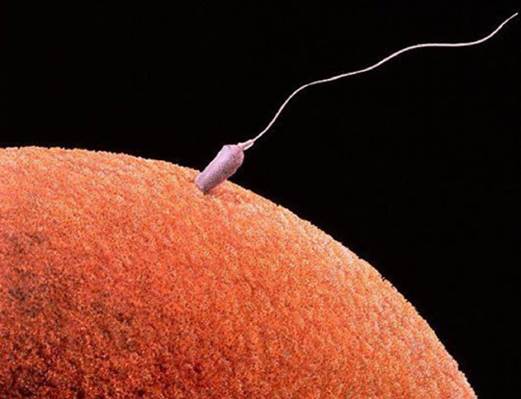At the 10th week, we can define
whether fetuses right-handed or left-handed.
Getting pregnant and having babies are ones
of the most marvelous and sacred things of the nature. In 9 months and 10 days
of pregnancy, women’s bodies have to change to adjust the pregnancy and foster
fetuses. Even the fetuses experience different developments to prepare for the
due day. Therefore, there’ll be interesting things about the changes of mothers
and fetuses in 40 weeks of pregnancy, especially fetal unexpected developments.
Interesting things about the conception
The conception happens when a sperm
connecting to an eggs. However, it’s surprising to know that that only sperm
have to fight against 300 million other sperms along the way from the vagina to
the oviduct.

There’re
over 300 million sperm taking part in the race of finding the egg but, there’s
only 1 of them have chance to get combined to the egg in order to make a
conception.
The path that sperms have to go through to
get the egg is very hard. In general, the amount of sperm coming out is about
two-thirds a teaspoon (about 2-6 mm3); each mm contain 60-150
million sperms whose one-fourths is abnormal, the rest is able to take part in
the egg race. In 300 million sperms in semen of an ejaculation, there’re only
couple hundreds of eggs and there’s only 1 sperm can get in the egg. The rest
is discharged from the vagina or destroyed by the acidic environment of vagina.
The other sperms can be swallowed by the cleaning cells in the vagina, go to
the wrong oviduct or can’t find the right egg.
24-hour period is the necessary time for a
sperm to get into an egg, make the conception happen without your awareness.
1 week is the time the blastocyst need to
(the inseminated and divided egg) go to the endometrium and nestle in it (often
in the highest part among 3 parts of the uterus). The placental also gets
formed up at the stage.
The gender of the fetuses all depends on
the X and Y of the father’s sperm. The eggs only have X chromosomes while the
sperms have the X or Y ones. If an egg has conception with a sperm contain X
chromosome, it will become a female fetus. In the case the egg combines with
the sperm containing the Y chromosome, it will become a male fetus. The chance
of having baby girls will increase if the copulation occurs in 2 to 3 days
before the ovulation. On the contrary, the chance of having baby boys will
increase when the copulation occur 1 day after the ovulation. However, those
are still comparative; the probability of having exact results is pretty low.
2% is the chance of a twin pregnancy. That
could be the twins that look like each other, which happen when an egg combine
with a sperm and split in two different zygotes. That often happens randomly.
The twins that have different appearances, happening when two eggs get ovulated
at the same time and fertilized with 2 different sperms, often happen in
families that have history of fraternal twins.

There’re
only 2% women who have twin pregnancy.
Unexpected developments of fetuses in the first 3 months
of pregnancy
In 4th week, an embryo has the
size of a little seed.
6 weeks after the conception is the time
fetuses have their first heartbeat. At the time, they are as little as a lentil
while uteruses start increasing the size, from the size of a big plum to the
size of an apple.
In 7th week, fetal brain is
divided into 3 separate parts, which is the foundations of the developments of
thoughts and actions in the future: the cerebrum is responsible for solving
problems, reasoning and storing memories; the midbrain control the strobes from
the body to the right brain; the hindbrain control physical activities like
breathing, heartbeat and muscle movements. This is also the time embryos are
formed and have their first movements shown out by the ultrasound.
In 8th week, the embryos
officially become fetuses with heartbeat; the risk of miscarriages is reduced
to 2%.
In 10th week, fetuses have the
size of a legume but, they have eyes, noses and mouths. 4 limbs with fingers
and toes are also grown. They even have nails and the foundations of milk
teeth.
Surprisingly, right-handedness and
left-handedness are also defined in the period of time, based on thumb sucking.
According to a research of Belfast University, fetuses were used to sucking
right thumb would become right-handed in the future and vice versa.

The
right-handedness or left-handedness is formed when fetuses in their 10th
week.
This is also the moment fetuses can afford
the development of communication in the future. If you pat the bump, fetuses
will leave the area that is affected by your pat, though; you can’t recognize
it. Their heartbeat is around 110-160/minute, twice as fast as ones of their
mothers. All the main organs like heart, lung, brain and intestine have had all
of their functions and will keep on developing in the next terms of pregnancy.
In 12th week, fetuses are as big
as a peach and they can feel the pain in every part of the body, just like
infants. Fetal reflections begin developing: if their hands touch their mouth,
their lips will open to put the fingers in for the sucking; if their hands
touch they eyes, they will blink. At the end of the first term of pregnancy,
fetuses are very much like human with chins, broad foreheads, noses and
eyelids.